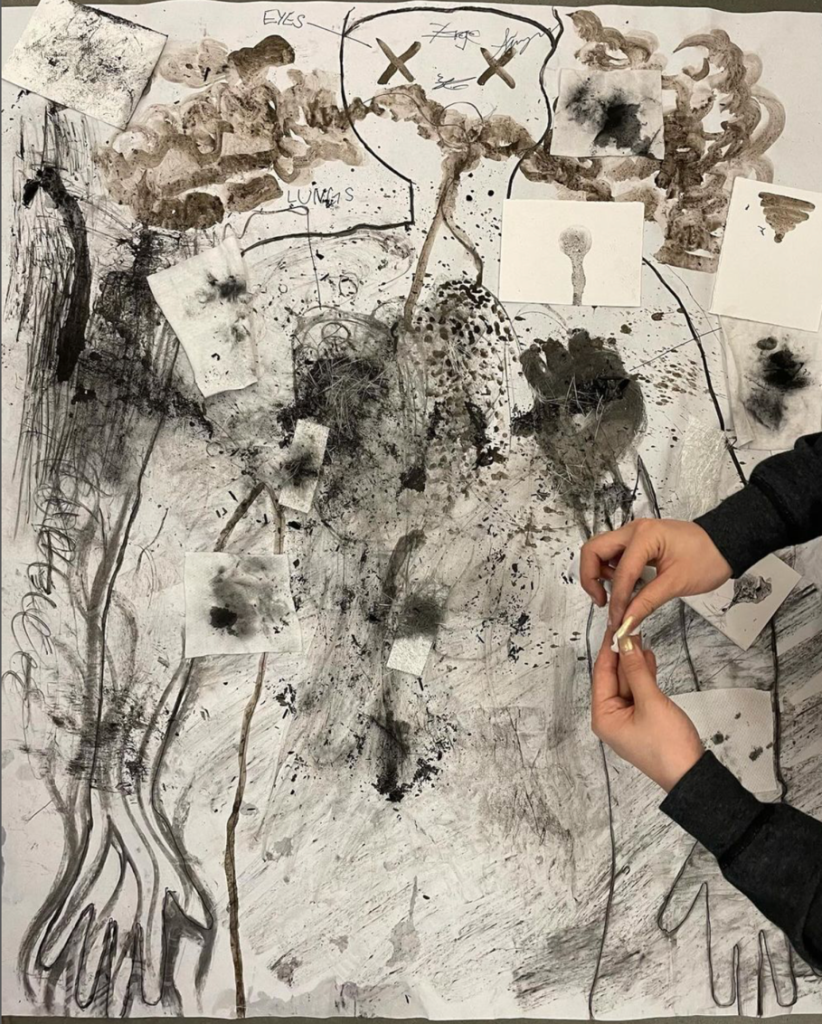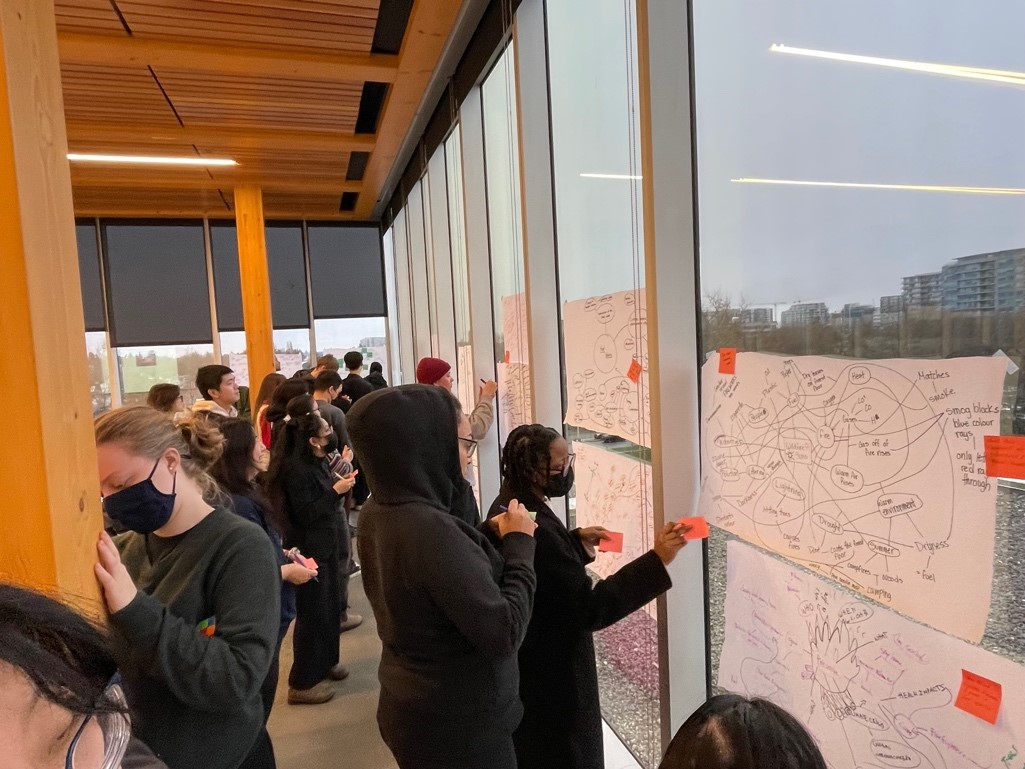by Sue Fairburn
Fire Weather, Fire Seasons and Clean Air Shelters

Image: Week 3 #cleanairshelterproject: exploration of charcoal as creative material, on and around the body, accumulation in the body.
We began with two some questions – How do you get students curious about a topic? How can collaborating across faculties expand the student’s learning about Climate Change through research? And how might we model for them ways of doing arts-based and design-based research? By showing students both what they know, and what they don’t know, we can model how research methods help us delve into a topic.
One of big climate change challenges of 2023 is Wildfires, which are becoming an ever-present experience and concern locally in BC, and around the world. With wildland fires comes issues of smoke and poor air quality. Fall 2023 saw the Climate+ Challenge host John Valliant’s Fire Weather : The making of a Beast (2023) was the basis for engaging the KPU community in conversations about wildland fires, communities, and climate change. It was this event that fed the conversation and led to a faculty collaboration between FINA (Fine Arts) and DEPD (Product Design). While the fields may seem directly related, the methods and modes differ and the sharing and engaging in those approaches enhances both teaching and learning. At the time, Liz Toohey-Wiese (ARTS) was developing her content for FINA 3202 – Art+ Climate Change – while I (WSD) was developing a project for DEPD 3610 on the design of Clean Air Shelters for BC Wildland Firefighters.
How did the collaboration develop? It took shape over two conversations and email exchanges – some directly relevant and others exploratory. The early conversations were super interesting – I learned how Liz approached Fire as both the source of creative materials and how she seeks to understand community and respond to their needs during wildfires. She shared some of her readings from the book she co-edited: Fire Season (First Edition, 2020) while I shared content and exemplars on how to map and visualize complex systems.
Each of us developed background content to share with students in advance and then expanded on it during the group sessions:
>In the first session, I introduced the students to systems mapping/ways to visualise complex information. The FINA and DEPD students mapped the complexities of climate change using large scale visualisations that identified connections between entities involved and , what flowed between them, and this led to areas to explore further. The mapping session involved both classes meeting and sharing over a three-hour session. The result was a series of large-scale maps that the students took away to guide their research.
>For the second sessions Liz shared a select reading from the Fire Season book and then introduced the students to the work of various artists using charcoal as a creative medium. This sharing of visual prompts was followed by an activity where the students mixed paint using ground wildfire ash and a binding agent, worked with charcoal directly, and used both materials to visualize the relationships between charcoal, wildfire smoke and the body. The resulting creative expressions served to extend the Design student’s imaginations in addition to their understanding of visible and invisible aspects of wildfires and wildfire smoke.
What we learned:
“I think maybe that is what happened with our collaboration as instructors is that we got to share what we know and be exposed to what we don’t know! I think that is useful for tapping into our own strengths as teachers, and seeing where we can grow in our pedagogy!” (Liz)
“Charcoal contains so many access points. Seeing the Design students embrace material exploration of wildfire charcoal and paint made with local wildfire ash led to expressions that were beautiful and informative, and fed their creativity in the context of a highly technical project.” (Sue)
And some suggestions that could be helpful for others interested in climate-related teaching collaborations:
1. Explore the Climate Change Moodle site to see other Faculty signed up – specifically: C+C Who is involved? Instructors & Courses
2. Join a C+C Book Club discussion to discuss the selected book and engage in discussion to identify shared interests and hear from others whose work is of interest https://dev.wordpress.kpu.ca/climatepluschallenge/fall-book-club/
3. Seek ways to reach-out/meet-up with other KPU Faculty. Spend time sharing and exploring how each of you approaches teaching climate change, including; methods, key readings/resources, activities, types of outcomes, and assessments, etc.
4. When supporting students in their research into climate change, seek approaches for making sense of scientific information, for looking at constraints, and for finding creative solutions to explore a topic.

Image: Week 2 #cleanairshelterproject: FINA and DEPD students work together to learn about and apply system mapping and ways to visualize complex information. The session ended with peer-to-peer sharing by posting their work, discussing it, and feedback on each other’s climate topics.
C+C: Bringing current events and issues into the classroom is part of teaching and germane to these times of changing climate. The Climate+ Challenge, funded by the Provost Office , provides opportunities for KPU faculty to seek ways to engage others across the KPU community in climate related activities and learning.